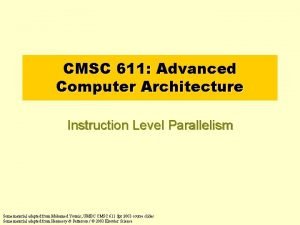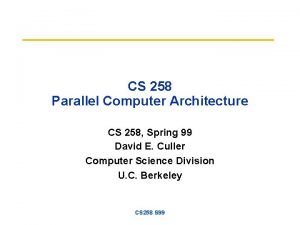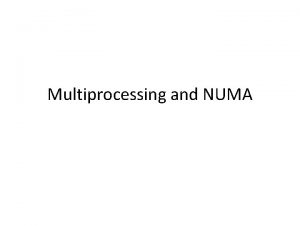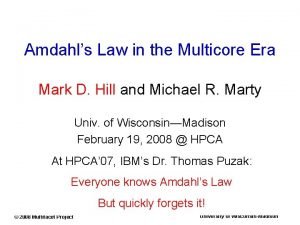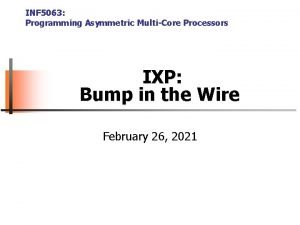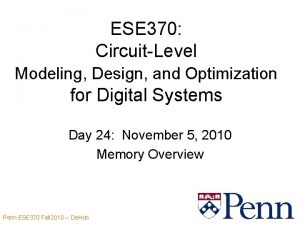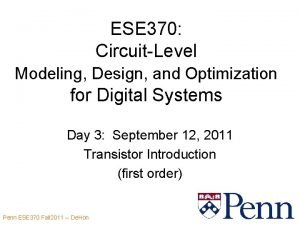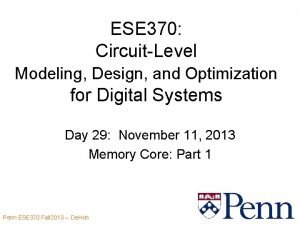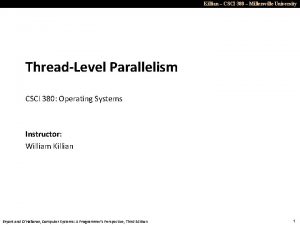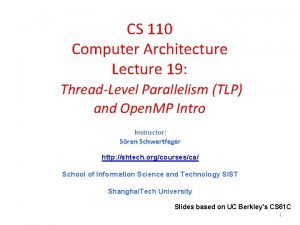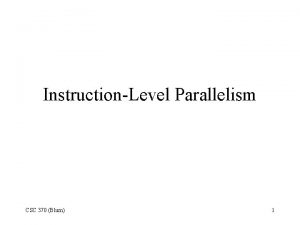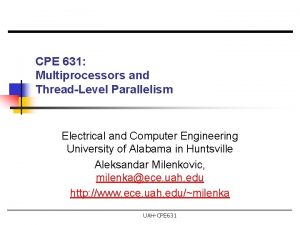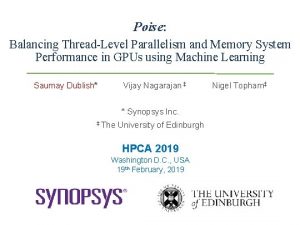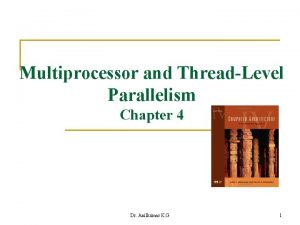Multicore and Threadlevel Parallelism CSCI 370 Computer Architecture




















![Case Study: Quicksort void quick. Sort(long int arr[], int left, int right) { if Case Study: Quicksort void quick. Sort(long int arr[], int left, int right) { if](https://slidetodoc.com/presentation_image/5dc4cb861deed7f493be416cbe9e98a0/image-21.jpg)


- Slides: 23

Multicore and Thread-level Parallelism CSCI 370 – Computer Architecture

Architecture Considerations with Multicore • Cache • Execution Units • Anything else?

False Sharing 0 1 2 3 4 5 6 7 psum Cache Block m+1 • Coherency maintained on cache blocks • To update psum[i], thread i must have exclusive access • Threads sharing common cache block will keep fighting each other for access to block

False Sharing Performance • Best spaced-apart performance 2. 8 X better than best adjacent • Demonstrates cache block size = 64 • 8 -byte values • No benefit increasing spacing beyond 8

Cache Coherency • A problem even on hierarchical architectures • Processor A writes location X • Processor B reads location X • What value does Processor B get? Before or after the write of A?

Multicore Processor Core 0 Core n-1 Regs L 1 d-cache i-cache … L 2 unified cache L 1 d-cache i-cache L 2 unified cache L 3 unified cache (shared by all cores) Main memory • Intel Nehalem (and newer) Processor • Multiple processors operating with coherent view of memory


Memory Consistency int a = 1; int b = 100; • Thread 1: Thread 2: Wa: a= Wb: b= 2; 200; Rb: Ra: What are the possible privalues printed? print • Depends onnt(b); memory consistency model (a); Thread consistency constraints Wa Rb Wb • Abstract model of how hardware handles concurrent accesses • Sequential consistency • Overall effect consistent with each individual thread • Otherwise, arbitrary interleaving Ra

Sequential Consistency Example Thread consistency constraints Wa Rb int a = 1; int b = 100; Thread 1: Wa: a= 2; Rb: pri nt(b); Thread 2: Wb: b= 200; Ra: print Wa (a); Wb Rb Wb Ra Wb • Impossible outputs Wa Ra Wb Ra 100, 2 Rb Ra 200, 2 Ra Wa Rb 2, 200 Rb 1, 200 Ra Rb 2, 200 Rb Ra 200, 2 • 100, 1 and 1, 100 • Would require reaching both Ra and Rb before Wa and Wb

Non-Coherent Cache Scenario • Write-back caches, without coordination between them Thread 1 a: 2 Cache b: 100 Thread 2 a: 1 Cache b: 200 int a = 1; int b = 100; Thread 1: Wa: a= 2; Rb: pri nt(b); print 100 Main Memory a: 1 b: 100 Thread 2: Wb: b= 200; Ra: print (a);

Snoopy Caches • Tag each cache block with state Invalid Cannot use value Shared Readable copy Exclusive Writeable copy Thread 1 Cache E a: 2 Thread 2 Cache E b: 200 Main Memory a: 1 b: 100 int a = 1; int b = 100; Thread 1: Wa: a= 2; Rb: pri nt(b); Thread 2: Wb: b= 200; Ra: print (a);

Snoopy Caches • Tag each cache block with state Invalid Cannot use value Shared Readable copy Exclusive Writeable copy Thread 1 Cache E 2 S a: Thread 2 Cache S a: 2 S b: 200 E b: 200 Main Memory a: 1 b: 100 int a = 1; int b = 100; Thread 1: Wa: a= 2; Rb: pri nt(b); print 2 Thread 2: Wb: b= 200; Ra: print (a); print 200 ¢ When cache sees request for one of its E-tagged blocks ¢ Supply value from cache ¢ Set tag to S

Snoopy Caches • Tag each cache block with state Invalid Cannot use value Shared Readable copy Exclusive Writeable copy Thread 1 Cache E 3 S a: 2 Thread 2 Cache SI a: 2 SI b: 200 E S b: 300 b: 200 Main Memory a: 1 b: 100 int a = 1; int b = 100; Thread 1: Wa: a= 2; Rb: pri nt(b); print 2 Wa: a = 3; print 200 ¢ Thread 2: Wb: b= 200; Ra: print (a); Wb: b = 300; When cache sees write for one of its S-tagged blocks ¢ Mark other cache’s tag to I ¢ Set tag to E ¢ update value

Out-of-Order Processor Structure Instruction Control Instruction Decoder Register s Op. Queue Instructio n Cache PC Functional Units Integer Arith FP Arith Load / Store Data Cache • Instruction control dynamically converts program into stream of operations • Operations mapped onto functional units to execute in parallel

Hyperthreading Instruction Control Op. Queue A Op. Queue B Reg A Reg B Instruction Decoder PC A Instructio n Cache PC B Functional Units Integer Arith FP Arith Load / Store Data Cache • Replicate enough instruction control to process K instruction streams • K copies of all registers • Share functional units

A Visual Guide to Hyper-Threading

A Visual Guide to Hyper-Threading

Summary: Creating Parallel Machines • Multicore • Separate instruction logic and functional units • Some shared, some private caches • Must implement cache coherency • Hyperthreading • • Also called “simultaneous multithreading” (SMT) Separate program state Shared functional units & caches No special control needed for coherency • Combining • Theoretical speedup of cores * hyperthreads over sequential

A More Interesting Example • Sort set of N random numbers • Multiple possible algorithms

A More Interesting Example • Sort set of N random numbers • Sequential quicksort of set of values [X] 1. 2. Choose “pivot” p from [X] Rearrange [X] into • [L] : values <=p • [R] : values >p 3. 4. 5. Recursively sort [L] to get [L’] Recursively sort [R] to get [R’] Return [L’] + [R’] What can be done independently?
![Case Study Quicksort void quick Sortlong int arr int left int right if Case Study: Quicksort void quick. Sort(long int arr[], int left, int right) { if](https://slidetodoc.com/presentation_image/5dc4cb861deed7f493be416cbe9e98a0/image-21.jpg)
Case Study: Quicksort void quick. Sort(long int arr[], int left, int right) { if (right – left <= 10) { insertion. Sort(arr, left, right); return; } int pivot = arr[(left + right) / 2]; int i = left; int j = right; partition (arr, &i, &j, pivot); quick. Sort(arr, left, j); quick. Sort(arr, i, right); }

Parallel Quicksort Performance • Sort 237 (134, 217, 728) random values • Best speedup = 6. 84 X

Parallel Quicksort Performance • Good performance over wide range of fraction values • F too small: Not enough parallelism • F too large: Thread overhead + run out of thread memory
 Define parallelism in computer architecture
Define parallelism in computer architecture Instruction level parallelism vs thread level parallelism
Instruction level parallelism vs thread level parallelism Ilp computer architecture
Ilp computer architecture Parallelism computer architecture
Parallelism computer architecture Parallelism computer architecture
Parallelism computer architecture Multiprocessor and multicore
Multiprocessor and multicore Computer architecture vs computer organization
Computer architecture vs computer organization Speedy transactions in multicore in-memory databases
Speedy transactions in multicore in-memory databases Multicore packet scheduler:
Multicore packet scheduler: Multiprocessor vs multicore
Multiprocessor vs multicore Amdahl's law in the multicore era
Amdahl's law in the multicore era Cache craftiness for fast multicore key-value storage
Cache craftiness for fast multicore key-value storage Pcie-1429
Pcie-1429 Obs multicore
Obs multicore Asymmetric multicore processing
Asymmetric multicore processing Autosar multicore
Autosar multicore Buses in computer architecture
Buses in computer architecture Flowchart for memory reference instructions
Flowchart for memory reference instructions Eecs 496 umich
Eecs 496 umich Instruction format of ibm 360 in system programming
Instruction format of ibm 360 in system programming Ese 370
Ese 370 Gate ese
Gate ese Ese 370
Ese 370 Ese 370
Ese 370


